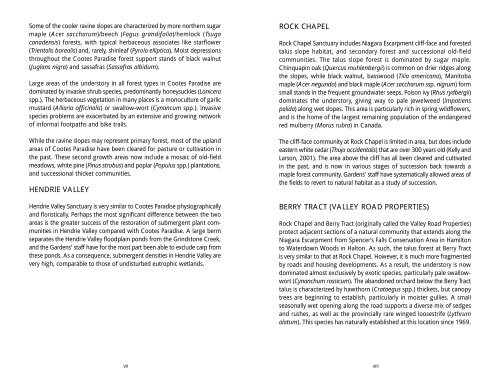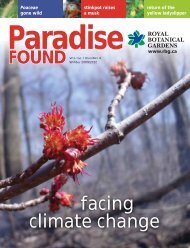Download a PDF of the updated Checklist of - Royal Botanical ...
Download a PDF of the updated Checklist of - Royal Botanical ...
Download a PDF of the updated Checklist of - Royal Botanical ...
Create successful ePaper yourself
Turn your PDF publications into a flip-book with our unique Google optimized e-Paper software.
Some <strong>of</strong> <strong>the</strong> cooler ravine slopes are characterized by more nor<strong>the</strong>rn sugar<br />
maple (Acer saccharum)/beech (Fagus grandifolia)/hemlock (Tsuga<br />
canadensis) forests, with typical herbaceous associates like starflower<br />
(Trientalis borealis) and, rarely, shinleaf (Pyrola elliptica). Moist depressions<br />
throughout <strong>the</strong> Cootes Paradise forest support stands <strong>of</strong> black walnut<br />
(Juglans nigra) and sassafras (Sassafras albidum).<br />
Large areas <strong>of</strong> <strong>the</strong> understory in all forest types in Cootes Paradise are<br />
dominated by invasive shrub species, predominantly honeysuckles (Lonicera<br />
spp.). The herbaceous vegetation in many places is a monoculture <strong>of</strong> garlic<br />
mustard (Alliaria <strong>of</strong>ficinalis) or swallow-wort (Cynancum spp.). Invasive<br />
species problems are exacerbated by an extensive and growing network<br />
<strong>of</strong> informal footpaths and bike trails.<br />
While <strong>the</strong> ravine slopes may represent primary forest, most <strong>of</strong> <strong>the</strong> upland<br />
areas <strong>of</strong> Cootes Paradise have been cleared for pasture or cultivation in<br />
<strong>the</strong> past. These second growth areas now include a mosaic <strong>of</strong> old-field<br />
meadows, white pine (Pinus strobus) and poplar (Populus spp.) plantations,<br />
and successional thicket communities.<br />
HENDRIE VALLEY<br />
Hendrie Valley Sanctuary is very similar to Cootes Paradise physiographically<br />
and floristically. Perhaps <strong>the</strong> most significant difference between <strong>the</strong> two<br />
areas is <strong>the</strong> greater success <strong>of</strong> <strong>the</strong> restoration <strong>of</strong> submergent plant communities<br />
in Hendrie Valley compared with Cootes Paradise. A large berm<br />
separates <strong>the</strong> Hendrie Valley floodplain ponds from <strong>the</strong> Grindstone Creek,<br />
and <strong>the</strong> Gardens’ staff have for <strong>the</strong> most part been able to exclude carp from<br />
<strong>the</strong>se ponds. As a consequence, submergent densities in Hendrie Valley are<br />
very high, comparable to those <strong>of</strong> undisturbed eutrophic wetlands.<br />
vii<br />
ROCK CHAPEL<br />
Rock Chapel Sanctuary includes Niagara Escarpment cliff-face and forested<br />
talus slope habitat, and secondary forest and successional old-field<br />
communities. The talus slope forest is dominated by sugar maple.<br />
Chinquapin oak (Quercus muhlenbergii) is common on drier ridges along<br />
<strong>the</strong> slopes, while black walnut, basswood (Tilia americana), Manitoba<br />
maple (Acer negundo) and black maple (Acer saccharum ssp. nigrum) form<br />
small stands in <strong>the</strong> frequent groundwater seeps. Poison ivy (Rhus rydbergii)<br />
dominates <strong>the</strong> understory, giving way to pale jewelweed (Impatiens<br />
palida) along wet slopes. This area is particularly rich in spring wildflowers,<br />
and is <strong>the</strong> home <strong>of</strong> <strong>the</strong> largest remaining population <strong>of</strong> <strong>the</strong> endangered<br />
red mulberry (Morus rubra) in Canada.<br />
The cliff-face community at Rock Chapel is limited in area, but does include<br />
eastern white cedar (Thuja occidentalis) that are over 300 years old (Kelly and<br />
Larson, 2001). The area above <strong>the</strong> cliff has all been cleared and cultivated<br />
in <strong>the</strong> past, and is now in various stages <strong>of</strong> succession back towards a<br />
maple forest community. Gardens’ staff have systematically allowed areas <strong>of</strong><br />
<strong>the</strong> fields to revert to natural habitat as a study <strong>of</strong> succession.<br />
BERRY TRACT (VALLEY ROAD PROPERTIES)<br />
Rock Chapel and Berry Tract (originally called <strong>the</strong> Valley Road Properties)<br />
protect adjacent sections <strong>of</strong> a natural community that extends along <strong>the</strong><br />
Niagara Escarpment from Spencer’s Falls Conservation Area in Hamilton<br />
to Waterdown Woods in Halton. As such, <strong>the</strong> talus forest at Berry Tract<br />
is very similar to that at Rock Chapel. However, it is much more fragmented<br />
by roads and housing developments. As a result, <strong>the</strong> understory is now<br />
dominated almost exclusively by exotic species, particularly pale swallowwort<br />
(Cynanchum rossicum). The abandoned orchard below <strong>the</strong> Berry Tract<br />
talus is characterized by hawthorn (Crataegus spp.) thickets, but canopy<br />
trees are beginning to establish, particularly in moister gullies. A small<br />
seasonally wet opening along <strong>the</strong> road supports a diverse mix <strong>of</strong> sedges<br />
and rushes, as well as <strong>the</strong> provincially rare winged loosestrife (Lythrum<br />
alatum). This species has naturally established at this location since 1969.<br />
viii



